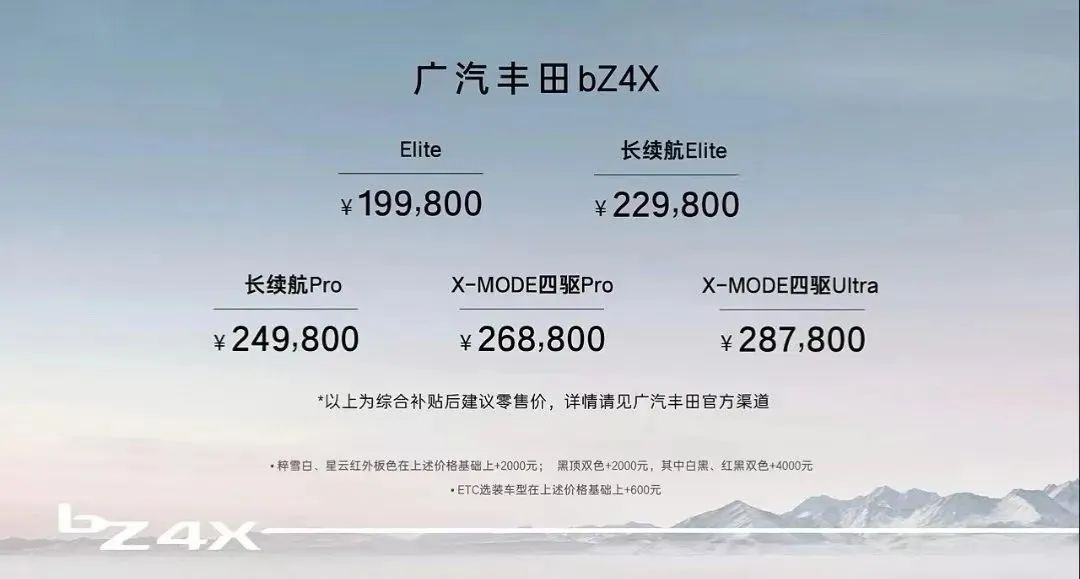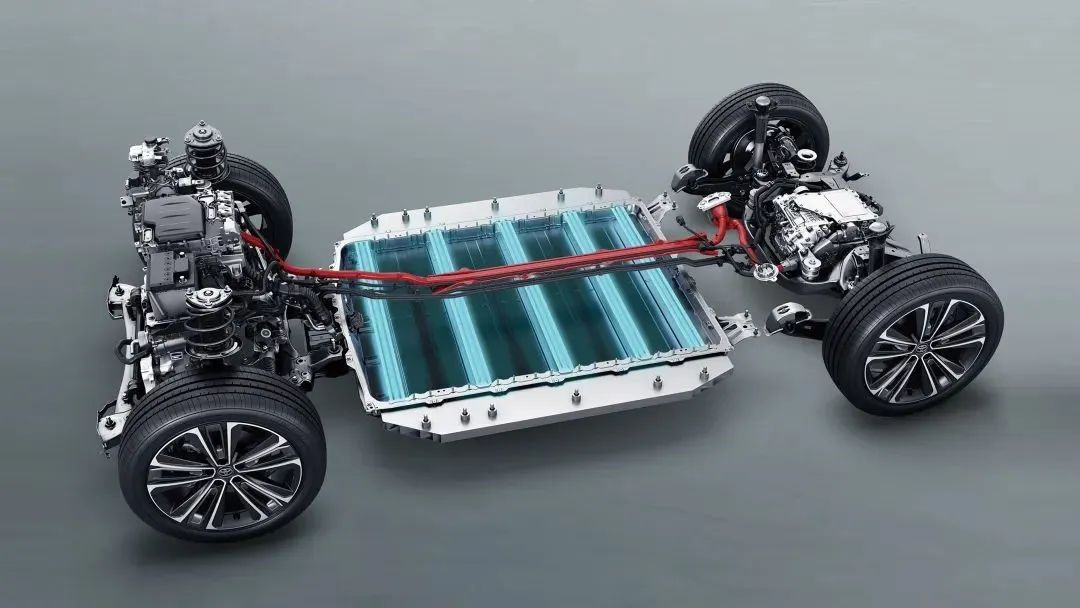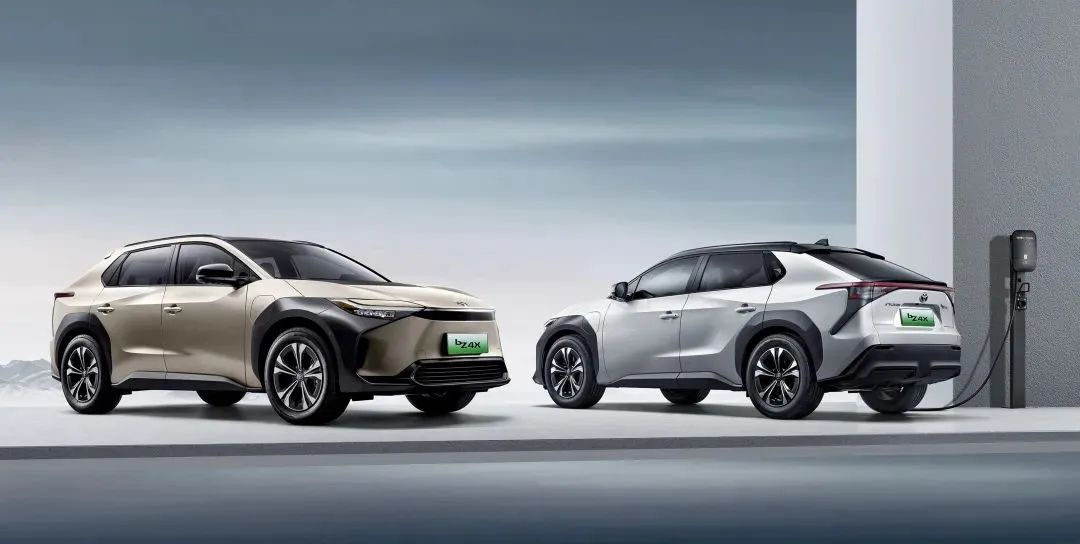Author|Nie Yiyao
On October 10th, GAC Toyota bZ4X was launched with a suggested retail price ranging from 199,800 to 287,800 yuan.

This is Toyota’s first e-TNGA pure electric vehicle, which was launched in China by GAC Toyota, with special significance.
In December last year, Toyota held a BEV Show on its carbon neutral strategy. During the show, Toyota announced 15 models led by the Toyota bZ series, all of which were powered by pure electric motors.
Akio Toyota, president of Toyota Motor Corp., stood in front of these pure electric models, with arms spread out and a smile on his face. The media in China, who always believed that Toyota was hesitant in the electric vehicle transformation, sighed with emotion that “Toyota is finally going all-electric.”

The first work of Toyota’s all-electric strategy is the bZ4X. It has a milestone significance for Toyota’s all-electric transformation.
The media and the industry undoubtedly paid close attention to and had high expectations for the bZ4X. However, some people who were previously worried about whether the bZ4X could successfully enter the domestic pure electric vehicle market and were not optimistic about the model, gradually spread their doubts in the media after the GAC Toyota bZ4X was launched, and the FAW Toyota bZ4X opened pre-sales on the same day.
Too Late to Catch the Opportunity?
It all started a few months ago.
On June 17th, GAC Toyota was supposed to launch the bZ4X but the press conference was cancelled urgently on the same day.
There were various rumors about the cancellation. GAC Toyota released a clarification statement, stating that the price disclosure section was cancelled because of the instability of raw material prices. However, pricing is often the main attraction of a launch event.
Shortly after, news of the recall of sold bZ4X by Toyota in North America reached China. Toyota claimed that “there is a risk of wheel detachment due to a problem with the bolts connecting the wheels.” Toyota’s North American factory suspended production of the bZ4X to investigate the cause of the defect and find a solution.
On April 12th this year, Toyota first launched bZ4X in North America. On May 12th, it was launched in Japan in a “subscription model” (only for renting, not for sale). The plan was to launch it in China on June 17th.As the most important market for Toyota’s comprehensive electrification strategy, some people originally questioned the order of bZ4X’s launch in China. Now it seems that it was actually a cautious move by Toyota.
Only by showing enough respect and attention to the Chinese market and users, which is in the midst of the electric vehicle battle, can one behave so cautiously. Chinese users are really tired of products with quality problems being launched into the market.
On October 6th, Toyota announced that the problem had been solved and that “the wheel bolts of the bZ4X will be replaced with newly designed bolts with washers to solve the problem of wheel detachment during vehicle operation.”
Subsequently, the domestic release of the bZ4X was quickly resumed. On the same day that GAC Toyota launched the bZ4X, FAW Toyota also began pre-sales of its bZ4X.
Overall, the launch pace of the bZ4X is tight yet cautious, reflecting Toyota’s long-standing carefulness and methodical approach, especially towards the Chinese market.
However, in the fiercely competitive domestic electric vehicle market, where everyone is rushing forward, the bZ4X as Toyota’s first truly pure electric vehicle model, only entered the game when the competition had become fierce, which inevitably led outsiders to think that it was too late to catch up and would have difficulty becoming mainstream.
Did the bZ4X really miss its opportunity? Or, did Toyota miss its opportunity in pure electric vehicles? Yes and no.
The global wave of electrification is surging, especially in the Chinese market, where the bZ4X and Toyota’s upcoming pure electric vehicle models did indeed miss the first wave.
However, the profound transformation of the automobile industry, driven by climate change and energy security, cannot be completed overnight, and may even take a long time to truly complete this round of change.
Judging by the results achieved in the current stage of automobile electrification, the waves of industry progress will continue to come one after another, all of which will be opportunities for newcomers to make a move. It’s okay to miss one wave, taking steady steps is the way to go far. Toyota still has a chance.
Is bZ4X lack of competitiveness?
Did Toyota miss the opportunity, and does the bZ4X lack competitiveness?
Since Toyota missed the first opportunity, some media and industry insiders cannot help but scrutinize the bZ4X with such a preconceived question in mind.
In a market dominated by many competitors such as Tesla, BYD, NIO, WM Motor, XPeng, Aiways, and Volkswagen ID., does the bZ4X have competitiveness? What is its competitiveness?
In my personal opinion, it does. The competitiveness of the bZ4X lies in the advantage of Toyota’s brand value system.
The labels of high cost performance, low failure rate, low use cost, high second-hand car residual value, excellent after-sales service, etc. are already deeply ingrained in people’s minds as Toyota’s brand value, together forming Toyota’s brand value system.
Toyota has also injected the advantages of this brand value system into the bZ4X. For example, in terms of pricing, the bZ4X of GAC Toyota has cleverly achieved a high cost-effectiveness ratio of pure electric vehicles of mainstream joint venture brands.
This can be seen from the comparison between the long-range version of bZ4X of GAC Toyota (229,800 yuan) and other long-range versions of pure electric vehicles of the same level of other joint venture brands.
At the same time, the price range of bZ4X of GAC Toyota is in the middle of the dumbbell-shaped structure that the Chinese electric vehicle market is currently presenting. Whether it is new forces, traditional brands, or joint venture brands, the number of entrants is relatively small compared to the two ends of the dumbbell, which is conducive to GAC Toyota’s bZ4X entering quickly.
Low failure rate, yes, Toyota’s quality has always been its trump card. As far as the “three-electronics” quality is concerned, Toyota has a bright spot to be proud of: of the more than 20 million different types of electrified products sold globally, there have been no accidents related to “three-electronics” in 25 years.
Toyota is obviously proud and extremely careful of its quality. To solve the problem of wheel bolt, it had to reconsider and set the conditions for fast charging in extremely low temperature states on the bZ4X before its launch.
In the new energy exclusive factory under the GAC Toyota e-TNGA structure, the bZ4X will be manufactured with the “zero defect rate” quality control standard inherited from Toyota’s high QDR genes.
In terms of low operating costs, GAC Toyota stated that the bZ4X long-range version has a CLTC working condition of 616 kilometers, and the optimal power consumption per hundred kilometers is only 11.6 degrees. The battery pack can still maintain 90% of its capacity after 10 years, and it is durable.

In addition, the bZ4X has intelligent black technology such as “coming when the sun is out”, high-efficiency solar charging dome, which can provide power for smart phones about 159 times a day and can travel about 1750 kilometers in a year.
Excellent after-sales service is reflected in the benefits provided to car owners of GAC Toyota’s bZ4X, including a three-electronics quality assurance of 10 years or 200,000 kilometers, free inspection/maintenance for 10 years or 200,000 kilometers, repurchase with no less than 60% of the original value within three years, and the rights to free gift and installation of a home charging pile or a 2,000 yuan charging card (one of two options).# Toyota’s Strategy for bZ4X
As for the intelligence configuration and computing power competition of Chinese electric vehicles, Toyota’s approach for bZ4X is to follow the trend, rather than rushing ahead. This is Toyota’s style – to not waste resources on uncertain areas without substantial progress. Instead, they strive to utilize their current advantages, which is a viable strategy.
bZ4X is not the Only Piece of the Puzzle
Some media and industry insiders believe that Toyota is “hesitant in the electrification shift,” and criticize some of Toyota’s executive’s statements as “reluctant to let go of the benefits of the fuel era” and “conservative and hesitant in electrification.”
However, the point-of-view and position of each person can be limited, which can result in prejudice. Take the electrification of cars, for example. We are in the forefront of the electrification trend and are biased toward pure electric vehicles that have been strongly promoted by policies for a long time.
In the minds of many people, EVs are exclusively BEVs (Battery Electric Vehicles), which is a narrow viewpoint. The promotion of new energy vehicles starting from one hundred years of fuel-powered cars is to solve global climate change and energy security issues and realize the common goals of carbon peaking and carbon neutrality as early as possible.
During this process, the electrification of vehicles has become a global consensus, and BEVs have become a notable means. Nevertheless, electrification does not only refer to BEVs. PHEVs (Plug-in Hybrid Electric Vehicles) and FCEVs (Fuel Cell Electric Vehicles) are also part of vehicle electrification.
Toyota is a global company, and their electrification strategy positions itself from a global perspective, covering various forms of electrification such as BEVs, PHEVs, and FCEVs. Although Toyota’s action for BEVs has been slightly delayed, the company has accumulated excellent technology and experience in the electrification of hybrid and fuel cell vehicles for several decades.
Meanwhile, Toyota proposes to promote the technological advancements and popularization of HEV (Hybrid Electric Vehicles), PHEV (Plug-in Hybrid Electric Vehicles), EV (Electric Vehicle), and FCEV (Fuel Cell Electric Vehicle), providing consumers with diverse choices.
This is the big picture of Toyota’s electrification strategy.
In recent years, both policies and the market have encouraged and responded to this diversified development direction of vehicle electrification.
This year, the production and sales of PHEVs have exploded in China, with figures surpassing BEVs, reaching unpreceded growth rates in September with year-on-year increases of 197.1%, 186.4%, and 170.7%, respectively.
Electric vehicle penetration has rapidly surpassed 30% in China, with plug-in hybrids playing an important role as a stalwart of the electrification movement in China’s automotive industry.
This suggests that electric vehicles will become more diverse in the future, with perhaps even more forms joining the fray.
Turning to Toyota’s electrification efforts, is battery electrification the only path forward? Not necessarily. Is the bZ4X the key piece that will determine Toyota’s electrification fate? Also uncertain. After all, Toyota has announced the development of 15 new battery electric vehicle models.
Some of Toyota’s electric vehicles may be chess pieces, with the bZ4X being important but not the only one.
This article is a translation by ChatGPT of a Chinese report from 42HOW. If you have any questions about it, please email bd@42how.com.
